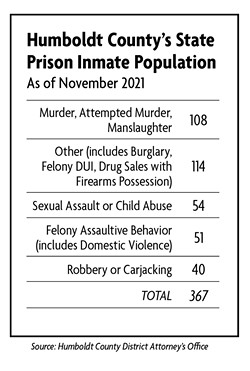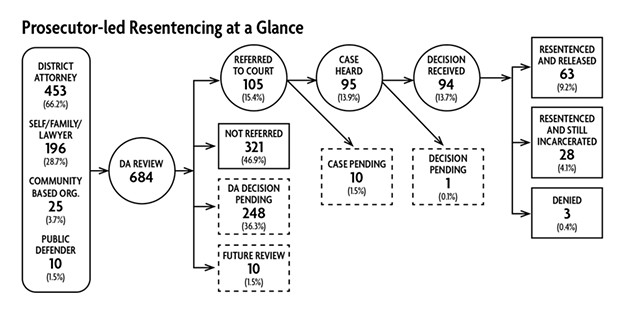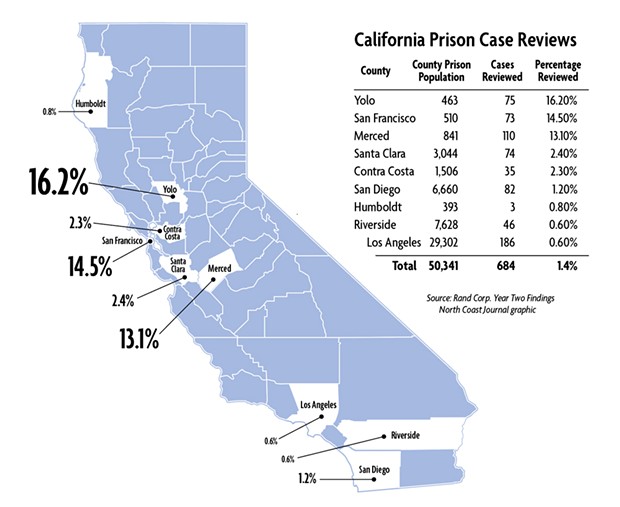The Outlier
All nine counties in a statewide resentencing project have seen inmates' prison sentences reduced. Except Humboldt.
By Thadeus Greenson [email protected] @ThadeusGreenson[
{
"name": "Top Stories Video Pair",
"insertPoint": "7",
"component": "17087298",
"parentWrapperClass": "fdn-ads-inline-content-block",
"requiredCountToDisplay": "1"
}
]
When Humboldt was selected as one of nine California counties to participate in a prosecutor-led resentencing pilot project, it was cause for celebration in the Public Defender's Office. Not only would a new state law give the district attorney's office the authority to ask the court to re-sentence convicts who are either serving exorbitant prison sentences or who have shown themselves to be rehabilitated while in custody, but the state funded the project in 2021, with $845,000 coming to Humboldt to fuel the effort.
"We were stoked," said Public Defender Luke Brownfield, explaining he believes some of the almost 400 people sent to state prison from Humboldt County are serving excessive sentences or have otherwise shown their continued incarceration is not in the interest of justice.
But two years into the three-year project, Humboldt is the only of the nine participating counties that has not seen one of its prison inmates resentenced. In fact, the Humboldt County District Attorney's Office has only seriously reviewed three cases as a part of the project and has spent just $56,312 of the $355,000 it was allocated as a part of the project, according to records released to the Journal through a public records request.
Statewide, the project had seen prosecutors initiate reviews of 684 inmates' cases as of July, with 105 referred to courts for resentencing. Of these, 91 people's sentences have been reduced and 63 have been released from prison. Not only do project proponents argue this gives rehabilitated people a second chance at life, with reverberating positive impacts, it also saves taxpayer money, as it costs approximately $100,000 annually to incarcerate someone.
Hillary Blout, the founder and executive director of the nonprofit For the People, which has spearheaded the initiative, said she believes it is going "wonderfully" statewide. Overall, she said, participating counties have been engaged and supportive. Asked specifically about Humboldt's status as the only county not to have seen an inmate referred for resentencing, Blout conceded, "some counties are moving faster than others," but noted each county has faced its own unique barriers to implementation. The project also represents a paradigm shift in the way criminal justice has historically been administered in the state.
"It involves looking at cases in a way DAs often have not looked at them in the past," she said. "But all of the counties within the pilot are extremely active in attending trainings and convenings and looking at how to be able to bring this work into their unique jurisdiction, and that's what we're excited about."
Between 1983 and 2000, "tough-on-crime" sentencing laws saw California's prison population increase by 225 percent before it peaked at 165,000 people in 2006, nearly double the capacity of the state's physical prisons, leaving inmates sleeping in gyms, hallways, dayrooms and holding cells. Prison overcrowding became so dire that the U.S. Supreme Court in 2011 ordered the state to release more than 30,000 inmates, finding conditions caused by the bulging population constituted cruel and unusual punishment.
Ensuing years have seen a series of sweeping reforms designed to reduce the state's prison population and the number of people held in state prisons had fallen to approximately 95,000 people as of January.
A former prosecutor with the San Francisco District Attorney's Office, Blout said she came to realize that this seismic shift in state sentencing law left some behind.
"I became kind of more acutely aware of the number of people in prison that were serving sentences that were inconsistent with current sentencing practices," she said, noting that other inmates have demonstrated they are "rehabilitated and reformed," yet face years or decades of continued incarceration.
So Blout said she began crafting what would become Assembly Bill 2942, a bill passed in 2018 that gave district attorneys statewide the power to recommend the recall and resentencing of a defendant. Blout said she believes elected prosecutors have a unique insight into who might warrant resentencing, as they would be aware of not just the facts of a convict's underlying case, but also its impact on victims and how an inmate's release might impact the larger community.
But while prosecutors seemed supportive of the new law and their newfound authority, few were using it. Blout said it became apparent a "big gap" existed between an office's desire to do this kind of resentencing work and the resources needed to facilitate it.
"There were just no resources for a county to take on this new, additional area of work," she said, adding that it also became evident that the resentencing effort would also require more collaboration between stakeholders — like prosecutors who work with crime victims, public defenders who work with defendants and community organizations that specialize in helping the recent incarcerated re-enter society — than currently existed.
So through her nonprofit For the People, Blout hatched the idea that became the pilot project.
"We were interested in piloting something that could get this work up and running in various offices around the state so we could look to see what works, what doesn't and what else is needed," she said.
In 2021, the state Legislature brought that vision to fruition, appropriating $18 million that would be divvied up among district attorney's offices, public defender's offices and community organizations in nine counties across the state, with an additional $1.4 million going to the RAND Corp. to evaluate the project's efficacy for the Legislature.
Humboldt County District Attorney Stacey Eads said Humboldt was selected to be part of the pilot after her predecessor, Maggie Fleming, saw Blout present at a statewide conference in 2020 and solicited For the People's help reviewing the county's prison population to determine if anyone might be a candidate for release. The smallest of the nine counties selected to participate, Humboldt was awarded $355,000 for its district attorney's office, $240,000 for its public defender's office and $250,000 for the district attorney to use to contract with a community organization to help with re-entry work.
Blout said some of the pilot project counties had already put prosecutor-led resentencing programs and systems in place prior to receiving the funding, noting this gave some a "head start" in the process. But she said counties have typically begun by taking a hard look at the data of their inmate populations to get a sense of who's in prison, how long they've been there and for what types of offenses.
"They will typically, looking at the data, identify the kinds of cases they want to start with," she said. "Ultimately, the DA determines which cases they want to take on."
So far in Humboldt, the answer has been none.
As of November of 2021, 367 people were serving state prison sentences meted out in Humboldt County. Of those, according to Eads, 108 had committed murder, attempted murder or manslaughter, 54 were in for sexual assault or molestation, 40 for robbery or carjacking, and 51 some type of felony assault. The other 114 people were serving sentences for burglary, felony DUI, drug sales with firearms enhancements and other crimes.
The eligibility criteria for the resentencing project in Humboldt County makes large swaths of those inmates ineligible for consideration.
Specifically, it says "all cases" are eligible for review except those involving "serious" or "violent" felonies as defined by the penal code, those that require sex offender registration or those that are considered "super strikes." Domestic violence offenses and crimes against police officers are "presumptively excluded" under the policy, which also notes that "victim objection is a presumptive end to the resentencing review process."
Under "factors to consider," the policy further specifies that qualifying inmates should have served a minimum of seven years of a minimum 15-year prison term. It also lists a host of other factors that should be considered, from the inmate's age at the time the offense was committed and the role substance abuse and mental illness may have played, to whether they pled guilty or were convicted at trial. The policy also lists other factors to be considered, including the inmate's conduct while in custody and risk assessment score, evidence of remorse, their age, job opportunities, community support and housing options.
Humboldt's criteria is clearly more exclusionary than that of other counties, which have combined to review nearly 100 assault with a deadly weapon cases, as well as 81 for murder and 27 for manslaughter, according to the RAND Corp. evaluation of the project's second year, with more than 20 of those homicide cases ultimately referred for resentencing. (RAND's next evaluation report, due out next year, will assess recidivism rates of those released but that data is not yet available.)
One of the primary implementation challenges identified in RAND's evaluation of the second year of the project is difficulties in district attorneys and public defenders working together. The report notes that PD offices "tended to want to play a more proactive role than the DAs envisioned" and help craft eligibility criteria, while the law gives prosecutors the sole authority to refer cases for resentencing.
It appears Humboldt County has not been immune to this challenge.
"To date, the Public Defender has received no formal list of potential candidates from the DA despite multiple written and verbal inquiries," the Public Defender's office wrote in a response to the Journal's public records request, adding that it only received the DA's eligibility criteria after it filed a public records request for it in July of 2023.
Sitting at a small conference table in the Public Defender's Office on Fourth Street, investigator Cisco Lassiter said he was immediately interested when Brownfield approached him about coming to work for him in a position entirely funded through the pilot project. A retired court-appointed investigator, Lassiter said the work appealed to him for a lot of reasons.
"The principal reason is, I believe, over-sentencing is a problem and mass incarceration is a problem," he said.
With limited communication from the district attorney's office and no candidate list to work from, Brownfield and Lassiter said they are essentially plowing their own road, looking to find inmates they believe warrant re-sentencing. Brownfield said he consulted with former Public Defender Kevin Robinson, who served on the job for more than a decade, to get ideas of likely candidates. But mostly he said Lassiter has been combing through the inmate lists provided by the state and conducting his own research, while also fielding calls from relatives of those incarcerated.
Once word got out about the resentencing project, family members started reaching out. Lassiter said he begins all these conversations by urging family members not to get their hopes up and warning that resentencing through the project is "an extreme long shot," but he said he knows people in seemingly hopeless situations find hope where they can.
Lassiter said he likes the work even though it can be daunting. He noted that some inmates' corrections files are more than 7,000 pages long, adding he's created a manual of prison system acronyms that itself stretches almost 40 pages. The work has its ups and downs, he said, noting the positives — like getting a supportive statement from a victim in a case — are tempered by those calls from an inmate's loved one looking for an update when there isn't one. Progress, he and Brownfield said, has been slow.
But they are hopeful. They said they have identified at least three candidates they believe warrant resentencing and are putting together a portfolio for each that they hope to present to Eads in the next couple weeks.
"Hopefully, we'll be able to sit down and discuss them," Brownfield said.
Speaking on the local radio show Talk Shop this fall, Eads brought up the resentencing pilot project, saying it has allowed her office to look at Humboldt County's state prison population to see if "there are individuals there that should perhaps be afforded the opportunity to have their sentences revisited or modified."
"Most significantly," she said, "is this an individual who has served a significant amount of time and, looking at their underlying criminal conduct and their rehabilitative efforts while incarcerated, is this an individual who may be a candidate for a lessened sentence and potentially a release back into the community?"
But then Eads implied there may not be many candidates.
"Over the years, Humboldt County has been very gracious in terms of giving folks opportunities and not just quickly sending people to state prison, so we don't have a number of folks who really fall within the obvious candidates of maybe they weren't given a fair sentence," she said, adding that other counties have used the state's three strikes law more "heavy handedly." She said, "I look at that as something our county should be very proud of."
Asked to clarify her comments when contacted by the Journal via email, Eads said she didn't have enough time to respond "in form and substance," but said generally she feels Humboldt County prosecutors have been "conservative" in seeking discretionary sentencing enhancements for people who have not committed "serious, violent and/or sex offenses."
Of the three cases her office has reviewed, all were suggested to it by For the People, Eads said. Two were deemed not to meet her office's criteria upon closer inspection, Eads said, while the office is "awaiting an in-depth review presentation by For the People staff" for the third.
The RAND evaluation notes that prosecutors have taken different approaches to staffing a unit to focus on resentencing work, noting that those who have created specialized positions funded by the project have said that has improved the "efficiency of the project." In Humboldt's case, Eads is working on the project personally, along with a business manager and analyst, according to her response to the Journal's records request.
Asked why it seems to be proving so difficult for her office to identify potential candidates for resentencing, Eads said the pilot project is an opportunity not a requirement, adding that any funds received for the project that go unspent will be returned to the state.
"There is not a requirement to resentence an incarcerated person through the prosecutor-initiated resentencing pilot program, rather it is an opportunity should the appropriate circumstances arise," she wrote. "We have been very well supported and assisted by For the People staff in evaluating the CDCR sentenced population from Humboldt County in search for potential candidates."
Thadeus Greenson (he/him) is the Journal's news editor. Reach him at (707) 442-1400, extension 321, or [email protected].
Comments (2)
Showing 1-2 of 2
more from the author
-
Gloria DeZordo: 1926-2024
- May 5, 2024
-
Failed Leadership
- May 2, 2024
-
'On Siemens Hall Hill'
How an eight-day occupation at Cal Poly Humboldt divided campus
- May 2, 2024
- More »
Latest in News
Readers also liked…
-
Through Mark Larson's Lens
A local photographer's favorite images of 2022 in Humboldt
- Jan 5, 2023
-
'To Celebrate Our Sovereignty'
Yurok Tribe to host gathering honoring 'ultimate river warrior' on the anniversary of the U.S. Supreme Court ruling that changed everything
- Jun 8, 2023



































